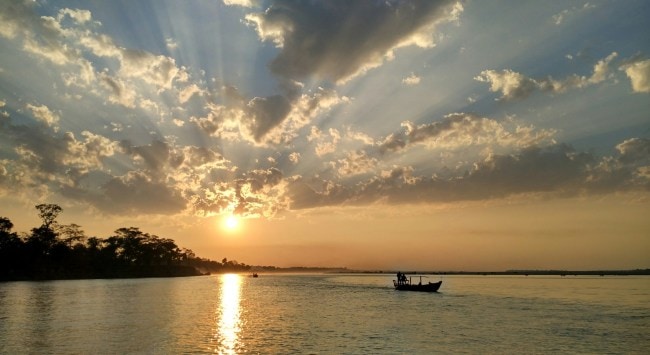Opinion Dissecting the myth of China’s control over the Brahmaputra
Even a hypothetical reduction in Chinese water contribution would unlikely harm India; instead, it might help mitigate annual floods in Assam
 Brahmaputra is powered by our geography, our monsoon, and our civilisational resilience — elements intrinsic to India’s natural environment and identity. But the discourse must move beyond mere water politics and look for a rational, fact-based approach to regional water governance and geopolitics
Brahmaputra is powered by our geography, our monsoon, and our civilisational resilience — elements intrinsic to India’s natural environment and identity. But the discourse must move beyond mere water politics and look for a rational, fact-based approach to regional water governance and geopolitics In recent days, discussions around water sharing and regional water security have taken a new turn in South Asia, especially following India’s decision to suspend the Indus Waters Treaty with Pakistan after the Pahalgam terror attack on April 22. Against this backdrop, Assam’s Chief Minister Himanta Biswa Sarma addressed concerns surrounding the Brahmaputra River, emphasising the importance of understanding its natural flow and reassuring the public about India’s water sovereignty.
His remarks, grounded in hydro-statistics and regional data, challenge false narratives that suggest China could disrupt water flow significantly, highlighting that the Brahmaputra largely depends on Indian monsoons and tributaries, not upstream sources.
This article underscores that even a hypothetical reduction in Chinese water contribution would unlikely harm India; instead, it might help mitigate annual floods in Assam. As the region faces severe flooding due to monsoons, India must emphasise resilience and infrastructure over fears of upstream interference. These insights reflect a deeper understanding of the river’s geographical and climatic realities, underscoring its strategic independence and the importance of fact-based policy-making in regional water management.
The Brahmaputra is known as the Yarlung Tsangpo in Tibet. Pakistan, historically reliant on the Indus waters, is now attempting to stoke fears about India’s water security through the Brahmaputra, asserting that China’s actions could threaten Indian stability and sovereignty.
There is an inherent myth in this as there is misrepresentation of a comprehensive hydro-geographical data. The Brahmaputra is primarily a rain-fed river system, with only approximately 30-35 per cent of its flow coming from China, mostly through glacial melt and rainfall that happens in the Tibetan region which is scanty. This covers the base flow of the river but the majority of the river’s water — about 65-70 per cent — arises within India itself, thanks to the monsoon rains that pour over the Northeast’s hilly terrains and the numerous tributaries feeding the river.
The Brahmaputra’s flow at key points exemplifies India’s water independence. At the Indo-China border, near the Tuting region in Arunachal Pradesh, the flow rate is around 2,000-3,000 cubic metres per second. During the monsoon season, as the river enters Assam’s plains, the flow swells to an impressive 15,000-20,000 cubic metres per second. These figures underscore that the river’s strength and volume are predominantly sustained within India’s climatic and geographical domain. India, thus, does not depend on upstream water flow from China to sustain its water needs.
This information points out that even in a hypothetical scenario where China reduces its contribution — an unlikely event given that China has never officially threatened or signalled such an intent — the impact on India’s water security would be minimal and potentially beneficial.
Reduced flow could mitigate the devastating floods that annually ravage Assam and the northeastern region, displacing hundreds of thousands and destroying livelihoods, as floodwaters inundate low-lying areas. This counterintuitive point highlights the fact that India’s water system is resilient and primarily driven by monsoon rains and local tributaries.
The irony is that while fears over China’s potential water withdrawal dominate discussions, the region is currently grappling with an acute flood crisis. Several parts of Assam and the greater Northeast are experiencing floods well above the danger level, driven by heavy monsoon.
India’s flood mitigation strategies should be aligned with this reality, focusing on improving infrastructure and resilience rather than worrying about threats that are largely hypothetical. In fact, if China were to modify its water flow, it could potentially alleviate some of these flood risks, as excess water often results from uncontrolled monsoon runoff and not upstream flow restrictions.
Pakistan has exploited the Indus Waters Treaty over decades and benefited disproportionately from water access, enabling its agricultural and industrial development at India’s expense. India could not build any infrastructure as it was bound by the treaty even to water states like Kashmir. With India now reclaiming its sovereignty over water resources, the narrative of dependency is being challenged robustly.
Sarma asserted that the Brahmaputra is powered by our geography, our monsoon, and our civilisational resilience — elements intrinsic to India’s natural environment and identity. But the discourse must move beyond mere water politics and look for a rational, fact-based approach to regional water governance and geopolitics.
The writer is a Clinical Associate Professor (Research) and Research Director at Bharti Institute of Public Policy, Indian School of Business (ISB). He teaches sustainability at ISB. He contributes to IPCC reports and has recently been selected as the Lead Author of the IPCC’s upcoming report on Cities and Climate Change




